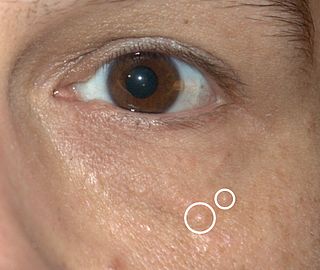Related Research Articles

Pemphigus is a rare group of blistering autoimmune diseases that affect the skin and mucous membranes. The name is derived from the Greek root pemphix, meaning "pustule".

Syringomas are benign eccrine sweat duct tumors, typically found clustered on eyelids, although they may also be found in the armpits, abdomen, chest, neck, scalp, or groin area, including genitals, in a symmetric pattern. They are skin-colored or yellowish firm, rounded bumps, 1–3 mm in diameter, and may be confused with xanthoma, milia, hidrocystoma, trichoepithelioma, and xanthelasma. They are more common in women and are most commonly found in middle-aged Asian women. While they can present at any time in life, they typically present during adolescence. They are usually not associated with any other symptoms, although can sometimes cause itchiness or irritation.

Erythema elevatum diutinum is a form of vasculitis.
Paraneoplastic acrokeratosis, or Bazex syndrome is a cutaneous condition characterized by psoriasiform changes of hands, feet, ears, and nose, with involvement of the nails and periungual tissues being characteristic and indistinguishable from psoriatic nails. The condition is associated with carcinomas of the upper aerodigestive tract.
Tripe palms, also known as acanthosis palmaris, is a medical sign characterized by thick ridged velvety palms, typically as part of a paraneoplastic syndrome. It resembles the lining of the stomach of some animals (tripe). Other signs that may be noted at the same time include most frequently acanthosis nigricans (AN), and less commonly finger clubbing and Leser-Trélat sign.
References
- 1 2 Wick, Mark R.; Patterson, James W. (July 2019). "Cutaneous paraneoplastic syndromes". Seminars in Diagnostic Pathology. 36 (4): 211–228. doi:10.1053/j.semdp.2019.01.001. ISSN 0740-2570. PMID 30736994.
- ↑ Fonia, Athina; Baran, Robert (2021). "Cutaneous paraneoplastic syndromes with nail involvement". In Lipner, Shari (ed.). Nail Disorders: Diagnosis and Management, An Issue of Dermatologic Clinics. Elsevier. pp. 175–182. ISBN 978-0-323-70924-8.